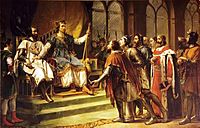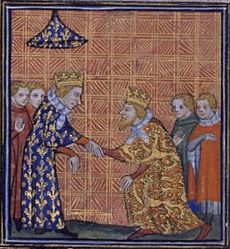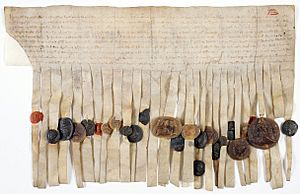Mise of Amiens facts for kids
| Settlement between King Henry III of England and oppositional magnates | |
|---|---|

Saint Louis's settlement between King Henry III of England and his barons, history painting by Georges Rouget, 1820
|
|
| Type | Settlement |
| Signed | 23 January 1264 |
| Location | Amiens, Picardy, France |
| Effective | Immediately |
| Language | Latin |
The Mise of Amiens was an important decision made by King Louis IX of France. It happened on January 23, 1264. This decision was meant to settle a big fight in England. The fight was between King Henry III of England and a group of powerful nobles, led by Simon de Montfort.
King Louis IX's decision strongly favored King Henry III. This made the rebellious nobles very unhappy. Because of this one-sided decision, a war broke out soon after. This war is known as the Second Barons' War.
Why the Conflict Started
By 1264, King Henry III's rule was causing many problems. There were big disagreements between the king and his nobles. Several things led to this conflict.
Foreign Influence and High Taxes
One main reason was the king's friends and family from other countries. These included relatives of Queen Eleanor of Provence and the king's half-brothers. English nobles were upset that these foreigners had so much power.
Another issue was King Henry's high taxes. He needed a lot of money for his plans. For example, he had agreed to accept the crown of Sicily for his son, Edmund. This plan was very expensive.
The Provisions of Oxford
In 1258, the nobles forced King Henry to accept a document called the Provisions of Oxford. This document meant that the king had to share his power. A council of powerful nobles would now help run the government.
However, King Henry tried many times to get rid of these rules. The rules were sometimes accepted and sometimes rejected. This made the situation very unstable.
Simon de Montfort's Role
A key leader of the nobles was Simon de Montfort, 6th Earl of Leicester. He was a powerful earl. Montfort had married the king's sister, Eleanor. But he later became a strong opponent of the king. He worked with other nobles like Richard de Clare.
In 1263, England was close to a civil war. Both sides agreed to let King Louis IX of France decide the matter. They hoped he could find a peaceful solution.
The Decision at Amiens
King Henry III traveled to France to present his case to King Louis. Simon de Montfort could not go because of an accident. Other nobles represented him instead.
King Henry's Arguments
Henry argued that his right to choose his own officials had been taken away. He said this went against his royal power. He also accused the nobles of damaging royal castles and lands. Henry demanded a large sum of money from the barons as payment for these damages. He also asked King Louis to free him from the Provisions of Oxford.
The Barons' Arguments
The nobles had their own complaints. They said that King Henry himself had agreed to the Provisions of Oxford. They pointed out that he had promised to follow these rules.
The nobles explained the good changes their council had made. They had appointed new officials to keep law and order. They also appointed new sheriffs in the counties. These sheriffs were supposed to be fair and change every year. The nobles argued that King Henry had broken these rules.
Louis IX's Ruling

On January 23, 1264, King Louis IX made his decision. He sided completely with King Henry III. Louis said that England had suffered a lot. He stressed the need for a solution.
Louis declared that all the Provisions of Oxford were invalid. He said King Henry did not have to follow them anymore. Castles that had been given to the nobles had to be returned to the king. Henry was free to choose his own ministers again.
The only thing the nobles received was a general pardon. This meant they would not be punished for their actions. Louis believed strongly in the king's power. He also respected the Pope's earlier decision against the Provisions. Henry's wife, Eleanor of Provence, who was Louis's sister-in-law, also worked hard for a good outcome for her husband.
It was clear that Louis's decision was very one-sided. Many people knew it would not solve the conflict.
What Happened Next
The decision at Amiens did not bring peace. Instead, it led directly to more fighting. The nobles, led by Simon de Montfort, felt they had no choice but to fight.
The Second Barons' War Begins
Fighting began in February. Montfort's sons attacked the lands of a royal supporter. King Henry gathered his army. The royal forces won a battle at Northampton.
Montfort was still in control of London. Henry regained control of other areas. Montfort tried to negotiate, but the king refused his terms. War was the only option left.
Battle of Lewes
The two armies met at Lewes on May 14, 1264. Simon de Montfort's forces won the battle. Even though they had fewer soldiers, they were victorious. King Henry's oldest son, Edward, led a part of the royal army. He chased some fleeing soldiers. This left the rest of the royal army open to attack.
After the battle, a new agreement was made called the Mise of Lewes. The Provisions of Oxford were brought back. Prince Edward was even held as a hostage.
Montfort's Rule and Defeat
Montfort's government soon faced problems. He made a treaty with the Prince of Wales. This made him unpopular with some English nobles.
In May, Prince Edward escaped. He joined forces with Gilbert de Clare, who was now on the king's side. Edward began to win back control.
On August 4, 1265, Montfort found himself trapped at Evesham. His army was much smaller than the royal army. Montfort was defeated and killed in the Battle of Evesham.
Even after Montfort's death, some rebels continued to fight. They held out at Kenilworth Castle. In October 1266, the Dictum of Kenilworth offered terms for rebels to receive pardons. By the end of the year, the castle surrendered.
Images for kids
-
Henry III doing homage to Louis IX of France. As Duke of Aquitaine, Henry was a vassal of the French king.





